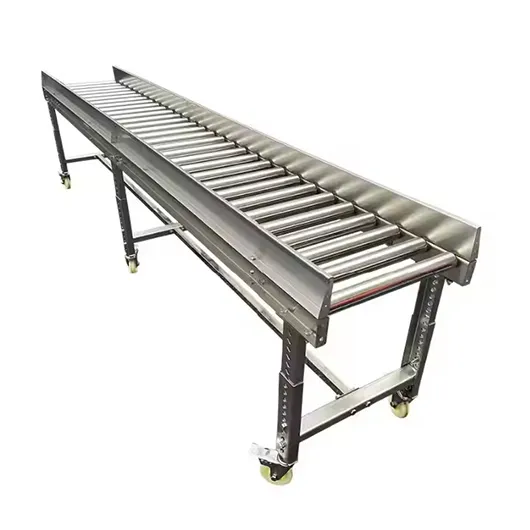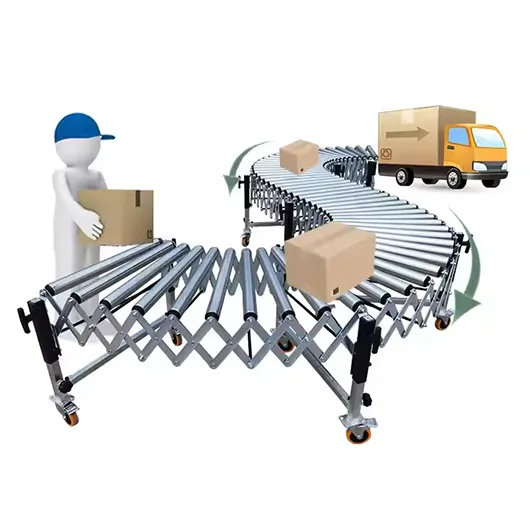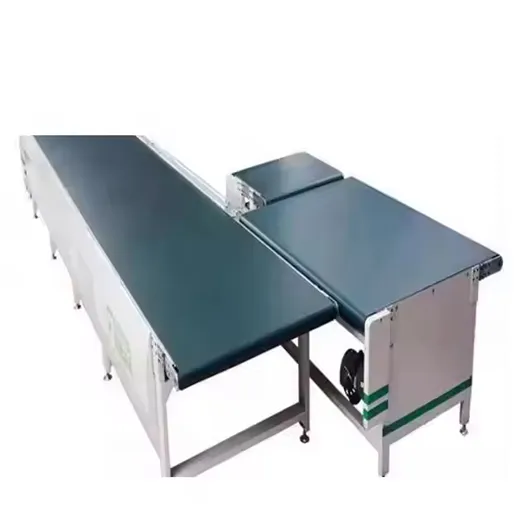Avoid your inquiry is delay response, please enter your WhatsApp/Skype along with the message, so we can contact you at the very first time.
We will reply you within 24 hours. If for urgent case, please add WhatsApp/WeChat: ,. Or call directly.
I see many factories that rely on conveyor systems, but it can be confusing to know which types work best. Conveyors transform production lines by reducing manual labor.
Conveyors come in many forms, but three common categories dominate the market. They each serve different industrial needs, from transporting light products to handling heavy loads.

Choosing the right conveyor matters because it affects speed, safety, and overall efficiency. Let’s explore the variety of conveyor systems, their basic components, warehouse applications, and the most common belt types.
I’ve heard many people ask about conveyor types. They want to know which design fits their production needs. I find it helps to start with the basics.
Different types of conveyors include belt conveyors, roller conveyors1, and chain conveyors. Each has unique advantages for moving products in various industries.
When exploring conveyor options, it’s helpful to break them down by design and functionality. The most commonly referenced categories — belt conveyors, roller conveyors, and chain conveyors — stand out for their versatility and industrial popularity. However, many subcategories exist, each designed to handle specific product sizes, weights, and environmental conditions.
Belt conveyors use a continuous loop of material, typically rubber or PVC, stretched over pulleys. The belt runs between a drive pulley and a tail pulley, with support rollers in between. This design is best for moving regular or irregularly shaped items, small packages, and bulk materials. The belt’s friction helps grip products, minimizing slippage during transportation. Some belt conveyors even feature specialty surfaces or sidewalls for inclines and declines.
Roller conveyors use cylindrical rollers mounted in a frame to move products. Powered roller conveyors have motorized rollers, while gravity-based ones use an inclined plane. They’re especially handy for boxes, pallets, and rigid items. An advantage of roller conveyors is their modular nature; one can add or remove sections to adjust the line’s length or integrate them with turns. Roller spacing can be customized for different product sizes.
Chain conveyors employ one or more endless chains driven by sprockets to move products along. They excel in moving heavier loads and handling extreme conditions, like high heat or dusty environments. The chains can interface directly with a pallet or attach to fixtures, letting them carry items that might not sit well on a belt or roller. Chain conveyors are common in automotive assembly lines or metal stamping facilities, where reliability under heavy loads is crucial.
Selecting the right conveyor often hinges on product type, weight, required throughput, and your available floor space. Factoring in maintenance requirements and energy consumption helps you pick a solution that balances efficiency with long-term costs. Each conveyor type—belt, roller, or chain—offers its own set of advantages, making careful comparison key to a well-optimized production line.
People often ask what exactly forms a “basic conveyor system2.” I usually explain that it’s a simple setup designed to transport products from point A to point B with minimal complexity.
A basic conveyor system includes a belt or chain loop, support structures, and a drive mechanism. It offers a straightforward way to move goods at a consistent pace.

A basic conveyor system typically consists of a few key components that work together to move items effectively. While industrial conveyors can become quite complex with sensors, automation controls, and sophisticated designs, the fundamental elements remain the same. Understanding these basics can help you choose or maintain a reliable conveyor line.
Every conveyor needs a solid frame. This frame is generally made of steel or aluminum, depending on the load requirements. Supports, often adjustable, keep the conveyor at the correct working height. A sturdy base prevents wobbling and misalignment, vital for smooth operation and minimizing wear.
In the simplest systems, a belt is the primary mode of transport. The belt is looped around two pulleys: a drive pulley and a tail (or idler) pulley. The drive pulley is connected to a motor, powering the belt’s movement. Alternatively, a basic chain conveyor uses an endless loop of chain instead of a belt, often better for heavier loads or in harsh environments.
The drive system usually includes an electric motor connected to the drive pulley via a gearbox or direct coupling. The speed of the conveyor is determined by the motor’s RPM and any gear ratio used. In a chain conveyor, sprockets are driven by the motor instead of pulleys. A simple on/off switch might control this motor, or a variable frequency drive (VFD) can allow for speed adjustments.
In belt conveyors, the pulleys provide tension and direction for the belt. Additional rollers might be placed along the underside to support the belt and the load above. Guides or side rails keep items from slipping off. Chain conveyors similarly rely on guides to prevent chain derailment.
Even a basic conveyor system usually includes simple guards and emergency stops. Guards protect workers from pinch points, while e-stop buttons ensure that the conveyor can be shut off quickly if needed. Some systems also feature sensors to detect jams or misalignment.
A basic conveyor system’s simplicity makes it cost-effective and easier to maintain. By focusing on stable frames, a well-chosen belt or chain, and a properly sized motor, you can achieve a straightforward solution that meets many material-handling needs without unnecessary complexity.
Warehouse managers often struggle to keep goods organized and flowing smoothly. Conveyors solve many challenges by moving products quickly, efficiently, and with minimal human effort.
In warehouses, common conveyor types include belt conveyors3, gravity roller conveyors, and automated conveyor systems for streamlined material handling.
Warehouses rely on conveyor systems to manage large volumes of goods. Whether you’re a distribution center handling thousands of SKUs or a smaller operation aiming to reduce manual handling, conveyors offer a consistent approach to moving and sorting items. Selecting the right conveyor setup can reduce labor costs, prevent injuries, and speed up throughput.
Many warehouses use belt conveyors to move boxes, poly bags, or even loose goods like mail parcels. Belts are especially helpful when you need a stable surface to prevent items from falling through. Warehouse belt conveyors often incorporate adjustable speed controls to adapt to varying loads, and side guards help keep products on track.
For zones where you simply need goods to roll downhill, gravity roller conveyors are popular due to their low cost and minimal energy usage. Items move by gravity on sloped roller beds. These conveyors are easy to install and can be reconfigured quickly, making them ideal for temporary or flexible warehouse layouts.
In busier warehouse sections, powered roller conveyors use motors integrated into the rollers or separate drive bands. This makes them more versatile than gravity conveyors because you can control flow, create accumulation zones, or divert packages off the main line without manual lifting. Some advanced systems include sensors that stop rollers when items accumulate, preventing collisions.
Large distribution centers often use conveyors with built-in sortation systems. These can detect barcode labels, RFID tags, or product dimensions to direct items onto different conveyor lines. Shoe sorters, cross-belt sorters, and tilt-tray sorters are examples of specialized conveyor-based sorting solutions. Automated sorting conveyors reduce manual scanning and picking errors.
Warehouse conveyor setups frequently incorporate guardrails, netting, and E-stop lines for safe operations. They also maintain ergonomic heights, so workers can place or retrieve items without excessive bending or lifting. Integrating conveyors with scanning, labeling, or packing stations further reduces manual handling and speeds up the entire warehouse process.
By choosing conveyors designed for specific warehouse needs—be it gravity-fed lines, powered rollers, or advanced automated sorting—companies can improve their order fulfillment rates and reduce labor overhead. Properly planned conveyor layouts ensure a smoother flow from receiving to shipping, enhancing overall warehouse efficiency.
I’m often asked which conveyor belt system appears the most in factories and warehouses. Belt conveyors typically top the list for versatility and accessibility.
The most common conveyor belt system is the flat belt conveyor4, widely used in manufacturing, warehousing, and distribution for its simple design and reliability.

Flat belt conveyors dominate the conveyor market for several reasons, including cost-effectiveness, ease of installation, and adaptability to a wide range of product types and weights. Below are the key aspects that make flat belt conveyors stand out as the most common choice.
Flat belt conveyors consist of a continuous loop of belt material stretched over two pulleys: a drive pulley and a tail pulley. Additional support rollers are included for longer spans. This straightforward design is easier to maintain and troubleshoot. Most adjustments revolve around tension control and belt tracking, both of which are manageable for in-house maintenance teams.
Belts can be crafted from rubber, PVC, PU, or other specialized materials. This variety allows them to suit different environments, from food-grade settings to high-temperature or chemical-exposed areas. The belt surface can also be textured or cleated if needed for inclined or declined conveyance, preventing product slippage.
Flat belt conveyors excel at handling a broad spectrum of products, from light poly bags to heavier boxes. Their continuous surface supports irregularly shaped packages that might get caught on roller edges. Many e-commerce fulfillment centers rely on flat belt conveyors for high-speed sorting, thanks to consistent product orientation and stable transport.
Another reason these systems are so common is their adaptability. Modular designs make them easy to extend, shorten, or incorporate curves. If a facility needs to expand production lines, adding new sections or merging with existing conveyors is relatively simple. This scalability is crucial for businesses expecting growth or seasonal surges in demand.
Flat belt conveyors also integrate well with sensors, barcode scanners, and robotic pickers. Because of their consistent speed and surface, it’s easier to sync up automated equipment. A controlled belt speed helps keep product spacing predictable, simplifying downstream processes like labeling, sorting, or vision inspection.
Overall, the flat belt conveyor’s prevalence stems from its cost-effectiveness, ease of setup, and broad utility. While other conveyor systems may be more specialized—like chain conveyors for heavy loads or roller conveyors for partial automation—flat belt conveyors remain the go-to solution for many industries. Their balanced mix of simplicity, versatility, and reliability ensures they will continue to be the most common conveyor belt system for years to come.
Conveyors come in many shapes and sizes, but three principal categories—belt, roller, and chain—form the core of modern material handling. By understanding basic systems, warehouse-specific solutions, and the most widespread belt options, businesses can choose a conveyor that optimizes efficiency and drives growth.
Learn how roller conveyors can streamline your material handling processes and adapt to different product sizes and weights. ↩
Explore this link to gain a deeper understanding of the essential components and functionality of basic conveyor systems. ↩
Explore the advantages of belt conveyors for efficient material handling in warehouses, enhancing productivity and safety. ↩
Explore the benefits of flat belt conveyors, including their versatility and cost-effectiveness, to understand why they dominate the market. ↩